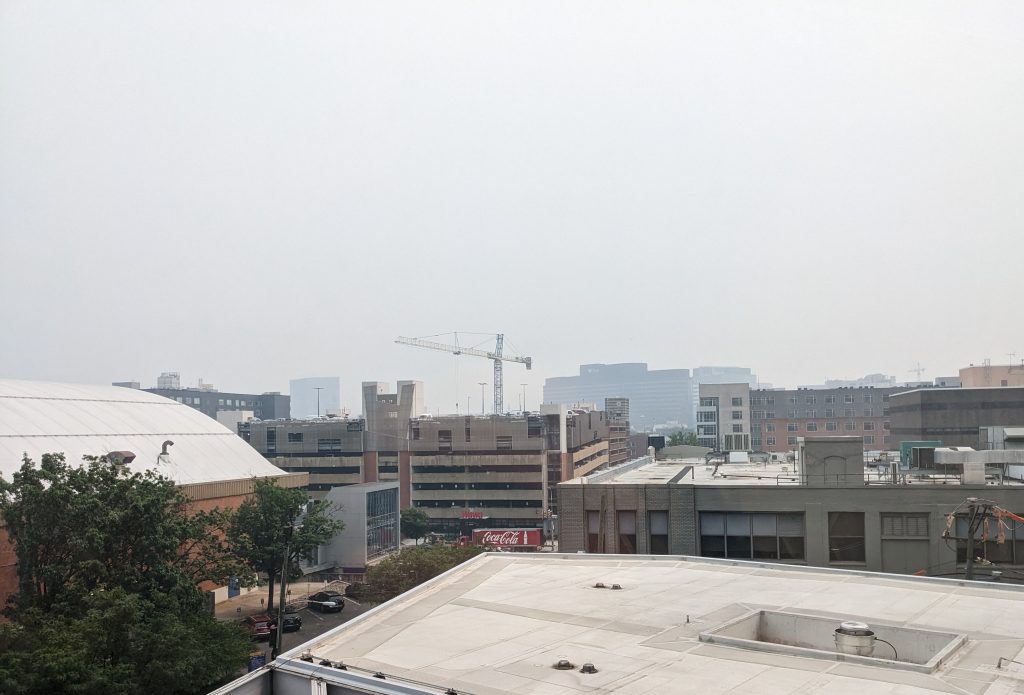
During the week of June 5, Philadelphia and other major areas along the East Coast were shrouded in eerie fog, leaving the sky a murky brown canvas and the air difficult to breathe. This wildfire smoke returned again June 29 to Philadelphia, bringing up essential questions about the state of our environment.
This issue was a larger side effect of huge wildfires raging across Canada, thousands of miles away, with the aftermath affecting a large part of the United States. This was an anomaly that truly spoke to a larger underlying issue of an environmental crisis that demands action.
To understand the gravity of this situation, The Triangle sat down with Andrew Lindsay, PhD, a researcher working under Ezra Wood’s, PhD, atmospheric chemistry research group at Drexel University. Lindsay actually specializes in this unlikely phenomenon and spends time exploring these anomalies in his lab.
On a normal day, Lindsay would fly all of his equipment to the source of the fire, whether that be Oregon, Washington, Idaho or California. But in this case, he had plenty of opportunities to sample the smoke right here, at home, in Philadelphia. Excitedly, Lindsay described how he had the opportunity to predict such events, including this one.
Starting off, the smoke originated from wildfires, which according to Lindsay can be broken down based on the “different chemical species in the air [they are] sampling from [their] lab and Disque [Hall].”
Beyond developing his own particulate matter reading, Lindsay plans on testing the Canadian wildfire smoke for organic components such as ozone and nitrogen oxides, components which we are seeing more of in the gradual warming of the earth.
While Lindsay prefaced by saying that his data was very preliminary, he did suggest the presence of “unique compounds,” the identity of which remains unknown. He hypothesized that they could be from emissions “transported all the way down wind, so maybe some of the emissions undergo chemistry [to] get some new things that aren’t initially found in wildfire smoke.”
On a normal day, Lindsay said air quality (measured in μg/m³) in Philadelphia is typically around 10. But at the height of the smoke in Philadelphia, he said “we’re getting upwards of more than 300 [μg/m³] at some points […] which is huge and it’s really bad.”
What we should be most concerned about with this metric is the particulate matter which was observed to be around PM 2.5 which according to Lindsay is the “size [that] specifically embeds in your lungs.”
The more particulate matter there is, the more harmful the air is for your lungs to constantly breathe. This poses a huge problem, especially after long term ingestion, as it does not just affect people with “respiratory and cardiovascular risks,” but will start affecting the community as a whole, not to mention how detrimental this smoke is to local wildlife and anything living outside as well. In large and frequent amounts, the smoke will undoubtedly employ irreversible damage.
As for why a fire and its effects were occurring to such a large scale, Lindsay had a few key insights. On an annual average, he said around 7 million acres of land are expected to burn in the United States. For reference, the 10 million acres of land that have already burned in Canada due to wildfires implies a possible underlying cause rather than standard meteorological variability. While the exact cause of the fire remains unknown, the current theory attributed the start of the fire to a lightning strike, which combined with the unusually warm and dry spring conditions creates “lots of areas that’s susceptible to burning,” said Lindsay.
While Lindsay could not say for certain that these unusual phenomena are due to climate change, or the gradual warming of the planet, he did say that unprecedented conditions of warm and dry weather increases “the risk for…more land area [being] burnt” severely.
With the wildfire smoke from Canada coming back in a second, less potent wave a couple weeks later to Philadelphia, it raises the question of whether this phenomena is a new normal.


